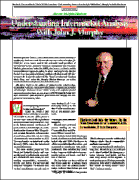V. 22:5 (72-79): Interview: Understanding Intermarket Analysis With John J. Murphy by Matt Blackman
Product Description
Interview: Understanding Intermarket Analysis With John J. Murphy by Matt Blackman
John Murphy has become a household name in the technical analysis community. And how could he not? He was the technical analyst for CNBC for seven years, and is the cofounder and president of MurphyMorris.com. His book Technical Analysis Of The Financial Markets, first written in the late 1980s, has become a classic, and its latest edition is required reading for those studying for the Market Technicians Associationís Chartered Market Technicians (CMT) designation. He is also the author of The Visual Investor and Charting Made Easy, and writes the Murphy Market Message, an online newsletter that can be found on StockCharts.com.
His latest book on the subject of global market relationships, Intermarket Analysis, has just been published. It updates many of the relationships discussed in his earlier texts, and explains pivotal market changes that have occurred since 1990. STOCKS & COMMODITIES contributor Matt Blackman spoke with John Murphy via telephone on December 2, 2003.
When did you first get interested in intermarket analysis?
Early on. When I first started working as a Early on. When I first started working as a technical analyst in the late 1960s, I was a stock analyst. In the 1970s, I gravitated toward the commodity market and I was in the futures business for the next 15 years while it went through an evolution from hard commodities like grains and corn into financials and currencies. I was there in the mid- to late 1970s, when contracts on currencies and US Treasury bonds were introduced, and in the early 1980s, when they introduced stock index futures. The stock market people on Wall Street just looked at stocks, and commodity people just looked at commodities. But in the futures world, we were trading commodities, currencies, stocks, and bonds, and we were the only ones doing this. For the first time we had everything in one pile and we were trading it all. I was managing money at the time and witnessed a number of correlations firsthand.
The origins of intermarket analysis!
The real key was when I started working for the Commodity Research Bureau (CRB) as a consultant. When the New York Futures Exchange launched a futures contract on the CRB index in the mid-1980s, I had access to all the research that had been done, and it referred to correlations with stocks and bonds. That solidified my belief in the strong correlation between commodity prices and bonds, and thatís how it evolved.
The key factor was the evolution of the futures industry. A futures trader has access to all the markets, and itís only a matter of time before you start seeing the correlations.
John Murphy has become a household name in the technical analysis community. And how could he not? He was the technical analyst for CNBC for seven years, and is the cofounder and president of MurphyMorris.com. His book Technical Analysis Of The Financial Markets, first written in the late 1980s, has become a classic, and its latest edition is required reading for those studying for the Market Technicians Associationís Chartered Market Technicians (CMT) designation. He is also the author of The Visual Investor and Charting Made Easy, and writes the Murphy Market Message, an online newsletter that can be found on StockCharts.com.
His latest book on the subject of global market relationships, Intermarket Analysis, has just been published. It updates many of the relationships discussed in his earlier texts, and explains pivotal market changes that have occurred since 1990. STOCKS & COMMODITIES contributor Matt Blackman spoke with John Murphy via telephone on December 2, 2003.
When did you first get interested in intermarket analysis?
Early on. When I first started working as a Early on. When I first started working as a technical analyst in the late 1960s, I was a stock analyst. In the 1970s, I gravitated toward the commodity market and I was in the futures business for the next 15 years while it went through an evolution from hard commodities like grains and corn into financials and currencies. I was there in the mid- to late 1970s, when contracts on currencies and US Treasury bonds were introduced, and in the early 1980s, when they introduced stock index futures. The stock market people on Wall Street just looked at stocks, and commodity people just looked at commodities. But in the futures world, we were trading commodities, currencies, stocks, and bonds, and we were the only ones doing this. For the first time we had everything in one pile and we were trading it all. I was managing money at the time and witnessed a number of correlations firsthand.
The origins of intermarket analysis!
The real key was when I started working for the Commodity Research Bureau (CRB) as a consultant. When the New York Futures Exchange launched a futures contract on the CRB index in the mid-1980s, I had access to all the research that had been done, and it referred to correlations with stocks and bonds. That solidified my belief in the strong correlation between commodity prices and bonds, and thatís how it evolved.
The key factor was the evolution of the futures industry. A futures trader has access to all the markets, and itís only a matter of time before you start seeing the correlations.
FOR THOSE ORDERING ARTICLES SEPARATELY:
*Note: $2.95-$5.95 Articles are in PDF format only. No hard copy of the article(s) will be delivered. During checkout, click the "Download Now" button to immediately receive your article(s) purchase. STOCKS & COMMODITIES magazine is delivered via mail. After paying for your subscription at store.traders.com users can view the S&C Digital Edition in the subscriber's section on Traders.com.
| Take Control of Your Trading. |
| Professional Traders' Starter Kit |
| All these items shown below only $430! |
| Click Here to Order |



